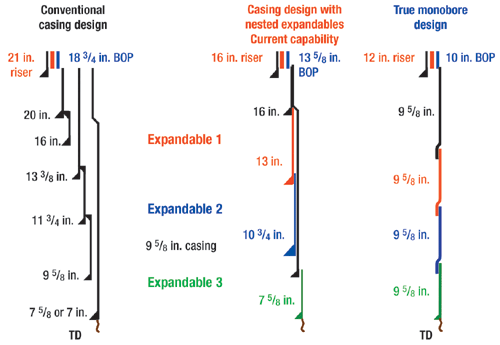|
Jan.
2002 Vol. 223 No. 1
Feature Article
|
DEEPWATER TECHNOLOGY
Expandable, solid tube technology development / application
 his
important technology development, now proven by several successful installations and field tests, was
introduced in an earlier session, then discussed in detail by Ken Dupal. his
important technology development, now proven by several successful installations and field tests, was
introduced in an earlier session, then discussed in detail by Ken Dupal.
SEPCo’s capability today, Paul Goodfellow noted,
is a conventional five-casing-string program with an 18-3/4-in. BOP system, producing a 9-5/8-in. string,
through which a 7-5/8-in. production liner can be run into an 8-1/2-in. open hole. Using solid expandable
tubular (SET) technology, a compact vessel can be used to achieve a 7-1/2-in. hole at TD with a 13-5/8-in. BOP
stack. The latter approach uses: 16-in. surface casing, two expandable strings, 9-5/8-in. conventional casing,
and one expandable string. The potential cost savings are up to 40%.
The evolution of well designs using expandable
technology is shown schematically in Fig. 1. Current capability is illustrated in the central figure and
described above. Evolution to a true monobore design is in final engineering stages. Onland testing should be
completed next year, with first application in 2003.
 |
|
Fig. 1. Evolution of well designs with
expandable technology. Monobore designs will see onland testing in 2002, with early-2003 application.
|
|
How it works. The concept of expandable casing
involves cold-working the tubular to the required size downhole. An expansion cone, or mandril, is used to
permanently mechanically deform the pipe. The cone is moved through the tubular by a differential hydraulic
pressure across the cone itself, and/or by a direct mechanical pull or push force. The differential pressure
is pumped through an inner string connected to the cone; mechanical force is applied by either raising or
lowering the inner string. Details of the process are described in the two-part article, "Industry
experience with solid expandable tubular technology."1
Questions and decisions at the design phase of
expandable technology development were / are: the expansion process – top down vs. bottom up; pipe
material – API grades vs. special alloys; connection development – expandable flush vs. welding;
mandrel design / lubrication; cementing techniques and casing accessories – conventional float equipment,
etc. vs. new; and "rig friendly" equipment and procedures.
Tests, status. The SET process has been
extensively tested, both onshore and in offshore deepwater wells. Three onshore tests were described by Dupal
in his presentation. In Shell’s Raul Tijerina 1 well, in 1999, 600 ft of 13-3/8-in. LSX 80 was
successfully expanded and pressure tested. In Shell’s Thomas Rife 13 well, in south Texas, in 2000, 2,016
ft of 13-3/8-in. LSX 80 was successfully expanded below and within 16-in. casing, to validate the system for
deep water.
And in Shell’s McAllen Ranch 106, 784 ft of 6-in.
openhole liner was run to 12,100 ft. It was expanded over 482 ft before encountering problems, because the
liner had become stuck due to differential pressure. This is believed to have affected the expansion process
by concentrating hoop stresses and potentially rupturing the liner. The failure prompted additional testing of
sticking mechanisms and redesign of the expansion cone.
The system has also been tested in offshore wells as
reported in the referenced paper.1 Dupal’s presentation described a recent application in
Mississippi Canyon 657, from the
Deepwater Nautilus semi, in 5,150-ft water, in a deep well planned to 28,000-ft TD. In this well, a
13-3/8-in. x 16-in. expandable was run over a 12,143 – 14,200-ft openhole interval and successfully
expanded, after some system pressure problems / corrections. And a 7-5/8-in. x 9-5/8-in. expandable was run
over the 20,431 – 21,623-ft openhole interval for a low-drilling-margin condition. It was expanded
without cementing in what Dupal called a "textbook job."
Monodiameter wells, conclusions. SEPCo says it
can utilize expandable technology to reduce well costs. It would start with a compact rig (13-5/8-in. BOP),
pre-installed mooring and a slender or "partial monodiameter" design. A monodiameter well can add
value by increasing the number of wells in the portfolio which can be drilled with a compact rig.
After reviewing well plan options and expanded tubular
limitations, 9-5/8-in. monodiameter casing with a 10.3-in. ID after expansion is the operator’s preferred
size. This technology is said to be SEPCo’s "next step" and will be the focus of 2001 –
2002 technology efforts.
In concluding the expandable tubular session, Dupal
said expandable technology has evolved from concept to field utilization in three years. Lab and initial
test-well programs have furthered understanding of the technology and enhanced system design. Failures in
early applications, and the resultant "learnings" from these failures, improved designs. Successful
applications were made on two deepwater and ultra-deepwater wells, with two expandable casings in each well.
Future applications include slender well capabilities with compact rigs and monobore well designs.

Literature
Cited
1 Dupal, K. K. et al., "Industry
experience with solid expandable tubular technology," World Oil, Part 1: July 2001, pp. 65 –
71, Part 2: August 2001, pp. 137 – 141.

 |
Shell’s
deepwater program: A broad-based technology commitment |
 |
Don Jacobsen,
Manager, Drilling & Completions, Shell Exploration & Production Co. (SEPCo), New Orleans; |
 |
Paul Goodfellow,
Drilling & Completions Operations Manager, Shell International Exploration E&P Inc., New Orleans;
|
 |
Ken Dupal, Sr.
Staff Drilling Engineer, SEPCo, New Orleans; and |
 |
Graham Brander,
Sr. Drilling Engineer, Shell International E&P Inc., Houston. Overviews of their presentations follow.
 |
|



